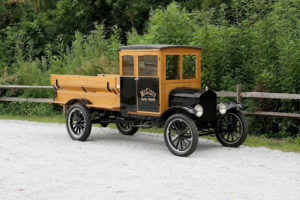Classic cars have an enduring appeal that captivates automotive enthusiasts. The timeless designs, powerful engines, and sleek lines evoke a sense of nostalgia and admiration.

While steel and chrome have long been the go-to materials for classic car construction, there is an intriguing world beyond these traditional options. In this article, we delve into the history of classic cars that dared to be different, boasting bodies made from unconventional materials. From the elegance of wooden wonders to cutting-edge carbon fiber masterpieces, these vehicles showcased the ingenuity and creativity of automotive design.
Wooden Wonders

In the early days of automobile manufacturing, wooden bodies were the norm. Skilled craftsmen meticulously handcrafted these vehicles, resulting in stunning works of art. One iconic example of a wooden-bodied classic car that captivated the world was the Ford Model T. With its elegant lines and warm wooden panels, it represented the epitome of craftsmanship. Another noteworthy wooden wonder is the Chrysler Town and Country, known for its luxurious appointments and timeless beauty. These wooden-bodied cars stand as testaments to an era when automotive artistry merged with natural materials, creating truly unique and exquisite automobiles.
Aluminum Beauties

As the need for lightweight and durable alternatives to steel arose, aluminum emerged as a prominent choice. Influenced by aircraft manufacturing techniques, aluminum-bodied cars made a significant impact on the automotive landscape. The Jaguar E-Type was often hailed as one of the most beautiful cars ever made, featuring an aluminum body that enhanced its performance and agility. Its sleek and aerodynamic design made it an enduring icon of automotive excellence. Similarly, the Audi A8 showcased the benefits of aluminum construction, combining strength and efficiency to create a luxurious and dynamic driving experience. These aluminum beauties epitomize the harmonious blend of form and function, highlighting the advantages of embracing unconventional materials.
Fiberglass Innovations

The advent of fiberglass revolutionized the automotive industry by providing a versatile and cost-effective alternative to traditional body materials. Fiberglass-bodied sports cars emerged as the embodiment of speed and style. One notable example was the Chevrolet Corvette, renowned for its iconic Stingray design. The lightweight and moldable nature of fiberglass allowed designers to create striking curves and sharp edges, giving the Corvette its distinctive aesthetic. Another remarkable fiberglass innovation was the Lotus Elan, a British sports car that perfectly balanced performance and handling. Fiberglass offered newfound freedom for designers to push boundaries and create bold and distinctive shapes that became synonymous with the golden age of sports cars.
Plastic Fantastic

Plastic once considered a revolutionary material, left an indelible mark on the automotive world. The Volkswagen Beetle, celebrated for its iconic shape and affordability, boasted a durable and lightweight plastic body. The plastic construction of the Beetle enabled the creation of its distinctive curves, making it instantly recognizable on the road. Perhaps the most famous plastic-bodied car of all time is the DeLorean DMC-12, immortalized by its appearance in the “Back to the Future” films. Wrapped in a polymer-based material, the stainless steel body panels of the DeLorean contributed to its futuristic aesthetic. Plastic-bodied cars demonstrated that unconventional materials could not only be practical but also enhance the distinctiveness of a vehicle’s design.
Carbon Fiber Exclusivity
Carbon fiber, prized for its exceptional strength and lightweight properties, has become synonymous with exclusivity in the automotive world. Super and hypercars often feature carbon fiber bodies to maximize performance. The McLaren P1, a hybrid hypercar, extensively utilized carbon fiber in its construction, resulting in a lightweight and aerodynamic masterpiece. Similarly, the Bugatti Veyron, one of the fastest production cars ever made, employed carbon fiber to achieve its extraordinary performance capabilities. Carbon fiber represents the pinnacle of modern engineering and showcases how advanced materials can push the boundaries of automotive innovation, redefining what is possible on the road.
Classic cars with unique body materials take us on a journey beyond the familiar steel and chrome. From the elegance of wooden wonders to the lightweight versatility of fiberglass and plastic, these cars challenge conventional norms and ignite our imagination. Aluminum beauties exemplify the fusion of form and function, while carbon fiber exclusivity demonstrates the cutting edge of performance and technology. These classic cars remind us that automotive design is not limited to traditional materials but can be a canvas for innovation and creativity. As we celebrate these unconventional materials, we recognize the remarkable craftsmanship and engineering that have shaped the world of classic cars, captivating enthusiasts for generations to come. In a world where steel and chrome dominate, these unique body materials have genuinely pushed the boundaries of automotive design, leaving an indelible mark on the history of classic cars.
If you like this article, please share it with your friends.

